ggtwotone is an R package that extends ggplot2 with dual-stroke and contrast-aware geoms. It helps you create clear, high-contrast annotations and lines that remain visible across complex or variable backgrounds.
What’s Inside
geom_segment_dual(): Dual-stroke line segments with vertical offset
geom_lm_dual(): Dual-tone regression line with contrast-aware strokes
geom_curve_dual(): Dual-stroke curved line annotations
geom_curve_dual_function(): Plot mathematical or statistical functions as smooth dual-stroke curves
geom_text_contrast(): Automatically switches between light/dark text color based on background
adjust_contrast_pair(): Helper function to find contrast-boosted color pairs using WCAG/APCA
Installation
You can install the development version of ggtwotone from GitHub with:
# install.packages("pak")
pak::pak("bwanniarachchige2/ggtwotone")Example
These are some examples which show you how to use the package:
library(ggtwotone) # automatically loads ggplot2 if it is not active
#> Loading required package: ggplot2
library(magick)
#> Linking to ImageMagick 6.9.13.29
#> Enabled features: cairo, fontconfig, freetype, heic, lcms, pango, raw, rsvg, webp
#> Disabled features: fftw, ghostscript, x11
library(grid)
img <- magick::image_read("man/figures/background_image.jpg")
# Convert image to a rasterGrob
bg_grob <- grid::rasterGrob(img, width = unit(1,"npc"), height = unit(1,"npc"))
# Plot
ggplot() +
annotation_custom(bg_grob, xmin = -Inf, xmax = Inf, ymin = -Inf, ymax = Inf) +
geom_curve_dual_function(
fun = dnorm,
xlim = c(-3, 6),
base_color = "blue",
linewidth = 2,
smooth = TRUE
) +
geom_curve_dual_function(
fun = function(x) 0.5 * exp(-abs(x - 2)),
xlim = c(-3, 6),
colour1 = "#FFFFCC",
colour2 = "#4B0000",
linewidth = 2,
smooth = TRUE
) +
coord_cartesian(ylim = c(0, 0.5)) +
theme_void() +
theme(
plot.background = element_rect(fill = "transparent", color = NA),
panel.background = element_rect(fill = "transparent", color = NA)
) +
labs(
title = "Curves over Image Background",
subtitle = "Dual-stroke rendering stays visible over image background"
)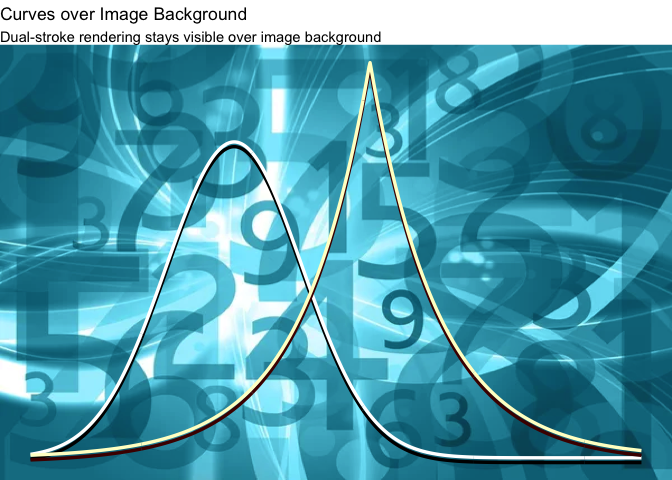
library(dplyr)
#>
#> Attaching package: 'dplyr'
#> The following objects are masked from 'package:stats':
#>
#> filter, lag
#> The following objects are masked from 'package:base':
#>
#> intersect, setdiff, setequal, union
# Zone-colored background
set.seed(42)
tile_df <- expand.grid(x = -7:7, y = -7:7)
zones <- c("Desert", "Forest", "Sea", "Urban")
zone_colors <- c(
"Desert" = "#EDC9AF",
"Forest" = "#14532d",
"Sea" = "#0F3556",
"Urban" = "#eeeeee"
)
tile_df$zone <- sample(
zones,
size = nrow(tile_df),
replace = TRUE,
prob = c(0.2, 0.2, 0.4, 0.2)
)
# Realistic wind vectors
set.seed(42)
n <- 25
wind_df <- data.frame(
x = sample(-4:4, n, replace = TRUE),
y = sample(-4:4, n, replace = TRUE),
angle = runif(n, 180, 270), # Southwest quadrant
speed = runif(n, 1.5, 4) # Speed in m/s
) |>
mutate(
xend = x + speed * cos(angle * pi / 180),
yend = y + speed * sin(angle * pi / 180)
)
# Plot
ggplot() +
geom_tile(data = tile_df, aes(x = x, y = y, fill = zone)) +
scale_fill_manual(values = zone_colors, name = "Zone Type") +
geom_segment_dual(
data = wind_df,
aes(x = x, y = y, xend = xend, yend = yend),
# colour1 = "#FFFFFF", colour2 = "#111111",
linewidth = 1.2,
arrow = arrow(length = unit(0.15, "inches"), type = "open"),
alpha = 0.9
) +
coord_fixed(xlim = range(c(wind_df$x, wind_df$xend)),
ylim = range(c(wind_df$y, wind_df$yend))) +
theme_minimal(base_size = 14) +
theme(
panel.background = element_rect(fill = "white", color = NA)
) +
labs(
title = "Wind Directions Across Zones",
subtitle = "Arrow direction and length represent wind flow and speed (m/s);\ndual-stroke improves visibility",
x = "Longitude",
y = "Latitude"
)
#> Warning in geom_segment_dual(data = wind_df, aes(x = x, y = y, xend = xend, :
#> Ignoring empty aesthetics: `colour1` and `colour2`.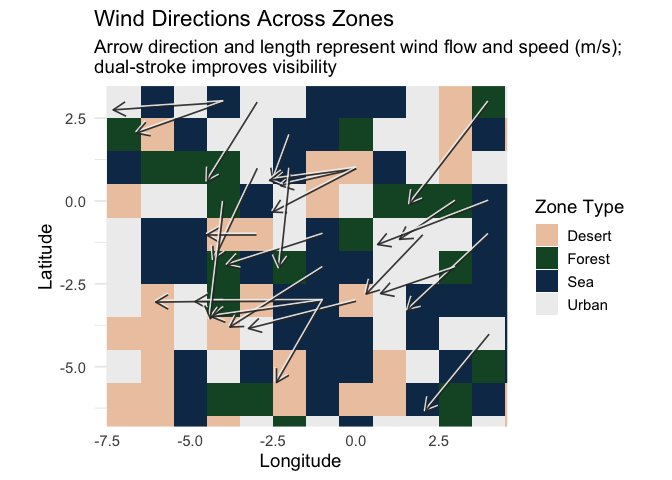
This example visualizes wind directions and speeds over a zone-classified terrain map using geom_segment_dual().
Arrow length is scaled by wind speed (in m/s), and dual-stroke styling ensures clear visibility across contrasting terrain types such as desert, forest, sea, and urban zones.
library(ggplot2)
library(ggtwotone)
df <- mpg
# plot
ggplot(df, aes(x = displ, y = hwy)) +
geom_point(color = "darkgreen", size = 3, alpha = 0.7) +
geom_lm_dual(
data = df,
mapping = aes(x = displ, y = hwy),
method = "lm",
formula = hwy ~ displ,
base_color = "#555555",
contrast = 4.5,
method_contrast = "auto",
linewidth = 1.2
) +
theme_minimal(base_size = 14) +
labs(
title = "Engine Displacement vs. Highway MPG",
subtitle = "Regression line with dual-stroke contrast for visibility",
x = "Displacement (L)",
y = "Highway MPG"
)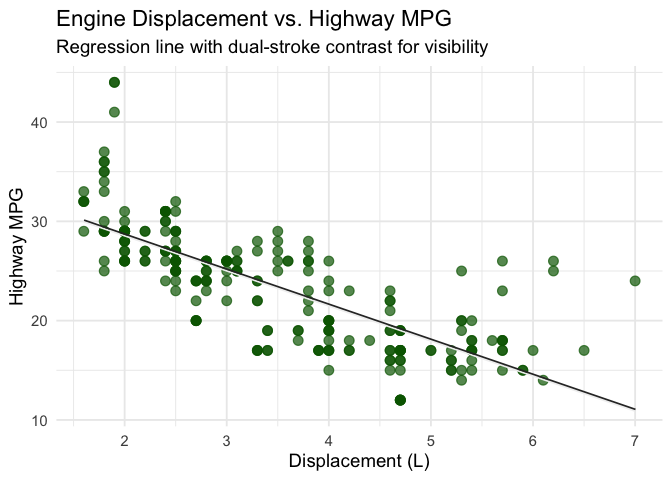
library(dplyr)
# Sample from real storm data
data("storms", package = "dplyr")
storm_subset <- storms %>%
filter(name == "Katrina", year == 2005) %>%
mutate(
x = lag(long), y = lag(lat),
xend = long, yend = lat
) %>%
filter(!is.na(x), !is.na(y)) # remove first row with NA lag
# Plot
ggplot(storm_subset) +
geom_segment_dual(
aes(x = x, y = y, xend = xend, yend = yend, group = 1),
color1 = "white", color2 = "black",
linewidth = 1.2,
arrow = arrow(length = unit(0.08, "inches"), type = "open")
) +
geom_point(aes(x = xend, y = yend, color = wind), size = 2) +
scale_color_viridis_c(option = "C", name = "Wind Speed") +
coord_fixed() +
labs(
title = "Storm Track of Hurricane Katrina (2005)",
subtitle = "Arrow direction shows storm movement; \nstroke ensures visibility on top of wind-colored dots",
x = "Longitude", y = "Latitude"
) +
theme_dark()
#> Warning: Duplicated aesthetics after name standardisation: colour1 and colour2
#> Warning in geom_segment_dual(aes(x = x, y = y, xend = xend, yend = yend, :
#> Ignoring empty aesthetics: `colour1` and `colour2`.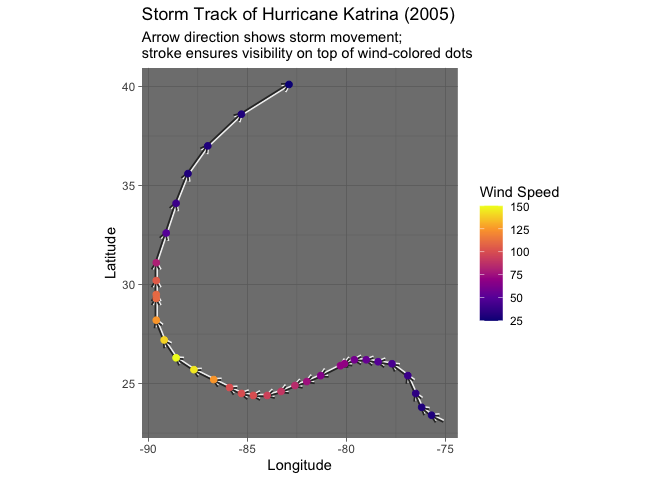
library(ggplot2)
library(magick)
img_path <- "micro_image.jpg"
um_per_px <- 0.05 # <-- calibration: micrometers per pixel
bar_um <- 10 # scale bar length in micrometers
# Load image as a background grob
img <- magick::image_read(img_path)
w <- magick::image_info(img)$width
h <- magick::image_info(img)$height
bg <- grid::rasterGrob(img, width = unit(1, "npc"), height = unit(1, "npc"))
meas <- data.frame(
x = 0.3218, y = 0.4507, xend = 0.7974, yend = 0.6371 # <-- adjust to your line
)
# Compute physical length for the label
dx_px <- abs(meas$xend - meas$x) * w
dy_px <- abs(meas$yend - meas$y) * h
len_um <- sqrt(dx_px^2 + dy_px^2) * um_per_px
lab <- sprintf("%.1f \u00B5m", len_um)
# Midpoint for the label
xm <- (meas$x + meas$xend)/2
ym <- (meas$y + meas$yend)/2
lab_df <- data.frame(x = xm, y = ym + 0.05, label = lab)
#Plot
ggplot() +
# background SEM image
annotation_custom(bg, xmin = 0, xmax = 1, ymin = 0, ymax = 1) +
# measurement line with dual stroke
geom_segment_dual(
data = meas,
aes(x = x, y = y, xend = xend, yend = yend),
colour1 = "#0D0D0D",
colour2 = "#FFFFFF",
linewidth = 1.2,
lineend = "round",
arrow = grid::arrow(ends = "both", length = unit(0.18, "in"), type = "open")
) +
# measurement label (contrast-aware)
geom_text_contrast(
data = lab_df,
aes(x = x, y = y, label = label),
background = "#444444",
size = 4.2
) +
coord_fixed(xlim = c(0, 1), ylim = c(0, 1), expand = FALSE) +
theme_void()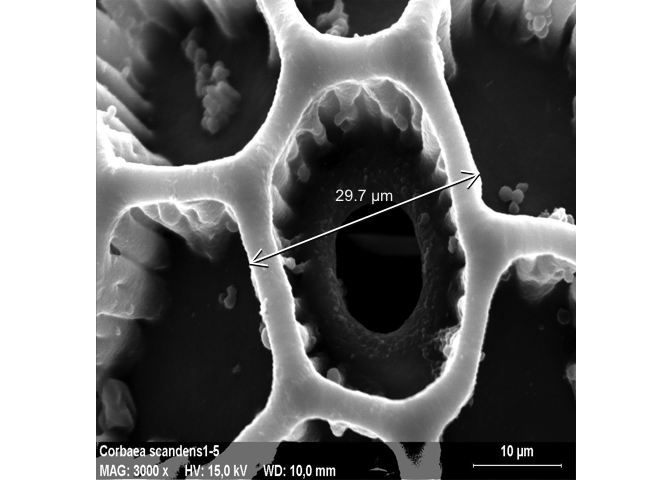
SEM micrograph with dual-stroke measurement overlay
# Packages
library(ggplot2)
library(dplyr)
library(sf)
library(scales)
library(rnaturalearth)
library(rnaturalearthdata)
# 1) Africa polygons
africa <- rnaturalearth::ne_countries(
continent = "Africa", scale = "medium", returnclass = "sf"
)
# 2) Simple variable (simulate GDP per capita, k USD)
set.seed(1)
africa$gdp_pc <- runif(nrow(africa), min = 1, max = 30)
# 3) Palette + per-country HEX for contrast
pal <- c("#0C2C84", "#41B6C4", "#A1DAB4", "#FFFFCC", "#FDAE61", "#D73027")
col_fun <- scales::col_numeric(palette = pal,
domain = range(africa$gdp_pc, na.rm = TRUE))
africa$fill_hex <- col_fun(africa$gdp_pc)
# 4) Label positions
labels <- africa %>%
mutate(
point = sf::st_point_on_surface(geometry),
lon = sf::st_coordinates(point)[, 1],
lat = sf::st_coordinates(point)[, 2],
area = as.numeric(sf::st_area(geometry)),
code = iso_a3
) %>%
dplyr::slice_max(area, n = 20)
# 5) Plot
ggplot(africa) +
geom_sf(aes(fill = gdp_pc), color = "white", linewidth = 0.2) +
geom_text_contrast(
data = labels,
aes(x = lon, y = lat, label = code),
inherit.aes = FALSE,
background = labels$fill_hex,
base_colour = "blue",
method = "auto", contrast = 4.5,
size = 2.5, fontface = "bold"
) +
scale_fill_gradientn(colours = pal, name = "GDP per Capita (k USD)") +
coord_sf(expand = FALSE) +
labs(title = "Simulated Africa Map with Auto-Contrast Labels", x = NULL, y = NULL) +
theme_minimal(base_size = 11) +
theme(panel.grid = element_blank(), axis.text = element_blank())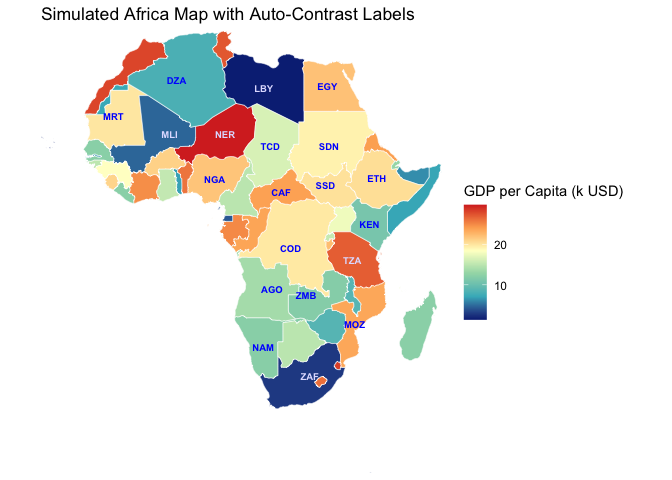
Drawing two lines side by side
The basic idea of drawing line segments with the segment_dual geom is to replace any line segment from A to B by two line segments drawn side by sidein different color hues chosen such that at least one of the coior hues has a sufficiently large (color) contrast to any background colors.
dframe <- data.frame(x =c(1,3,5), xmax = c(2, 4, 6), y = c(3,2,1), ymax=c(3,4,5), group = 4:6)
dframe |>
ggplot(aes(x = x, xend=xmax, y = y, yend=ymax)) +
geom_point(size = 5) +
geom_point(aes(x = xmax, y = ymax), size = 5) +
geom_segment(aes(group = group), linewidth = 20, alpha = 0.5) +
geom_segment_dual(aes(group = group, color1 = factor(group)), linewidth = 20, alpha = 0.5) +
theme_bw() + theme(aspect.ratio = 1/3) #+
#> Warning in geom_segment_dual(aes(group = group, color1 = factor(group)), :
#> Ignoring empty aesthetics: `colour1` and `colour2`.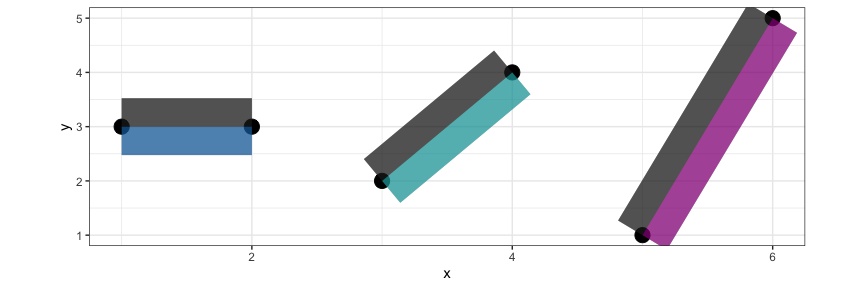
# geom_point(size = 5) +
# geom_point(aes(x = xmax, y = ymax), size = 5)Motivation
In real-world plots, especially on mixed backgrounds (grayscale tiles, images, or map layers), default ggplot2 annotations can disappear. ggtwotone solves this with:
Dual-stroke visibility: top and bottom layers ensure readability
Contrast checking: uses APCA/WCAG to optimize color pairing
Fallback safety: gracefully assigns black/white when needed
You can explore all functions in the Reference Manual, or see them in the R help tab after loading the package.